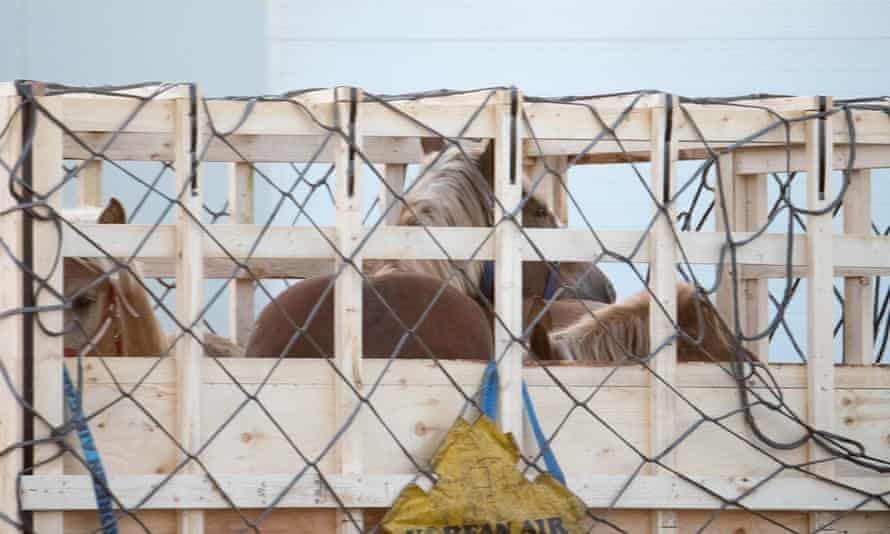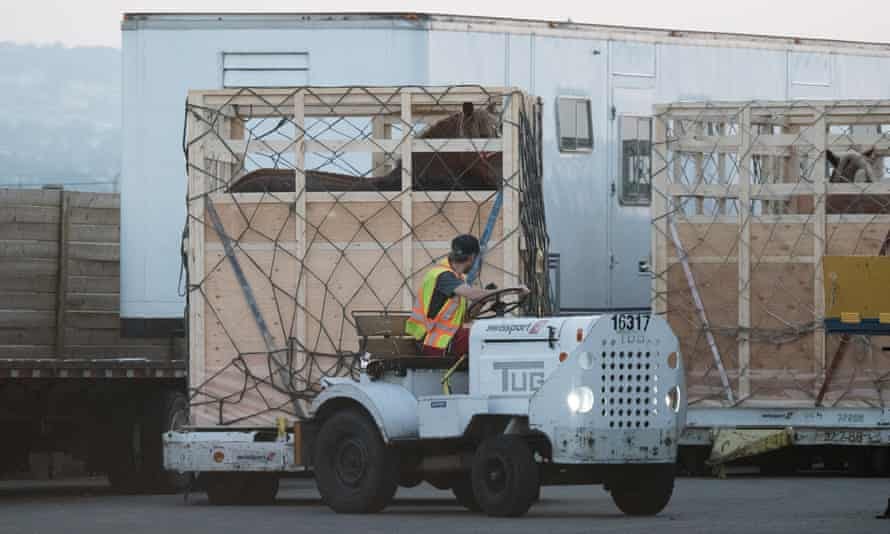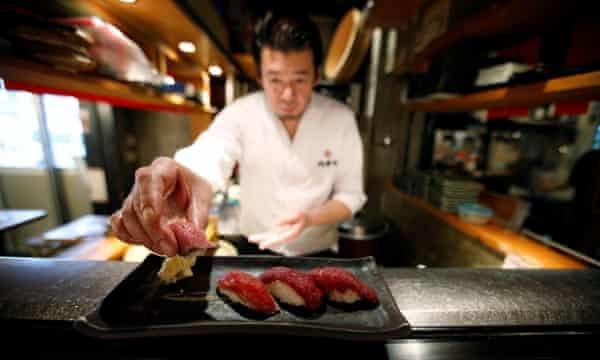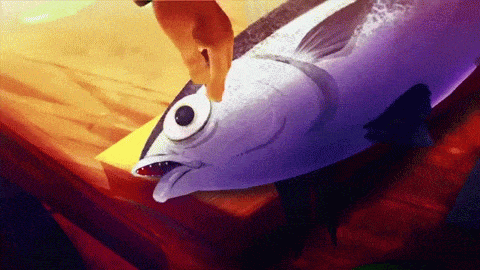The washoku myth was UNESCO registered in 2013.
Then suddenly in 2013, Japan commenced importing live horses to eat raw horsemeat as part of washoku. France and Canada were ready to supply.
Starting in 2013, up to 40,000 live horses have been crammed live in crates without water or food or room to move, to complete the myth that washoku is about meat eating Japanese.
And it all has to be eaten raw.
Protests at ‘inhumane’ export of live horses to Japan for food
The Guardian
Mar 27, 2021
https://www.theguardian.com/environment … n-for-food
Activists seek ban on flying horses to Japan with thousands sent every year from Canada and France

- Some of the 40,000 horses flown to Japan in similar crates from Canada since 2013. Canadian law allows them to be exported without food, rest or even water for up to 28 hours. Photograph: Canadian Horse Defence Coalition
Tens of thousands of horses are being subjected to long-haul flights, confined in crates with no food or water, to meet demand for horsemeat in Japan.
Since 2013, about 40,000 live horses have been flown to Japan from airports in western Canada. Under Canadian regulations, the journey can stretch up to 28 hours, during which the animals are allowed to go without food, water or rest.
The multimillion-pound global trade in fresh horsemeat to Japan is dominated by Canada and France. The little-known sector has burst into public view in Canada in recent years, fuelled by footage captured by campaigners of the near-weekly flights.
The footage prompted one vet, Judith Samson-French, to travel to the Calgary airport three times to see for herself what was happening. “As a veterinarian, I did not like what I saw,” she said. “These horses have not been trained nor conditioned for this kind of transport.”
She watched as the horses were loaded, in groups of three or four, into wooden crates that leave just the top of the animal visible. “You hear them in the crates,” said Samson-French. “There’s a lot of kicking going on there.”
At times, the horses appeared to be too tall to comfortably fit into the crates, she said. “These are big horses,” she added. “It’s absolutely impossible for a horse to lay down in those crates.”
She worried that the crating of horses, combined with the animals’ high centre of gravity, could prove dangerous on a plane.
Once they land in Japan, the horses are taken to a government quarantine facility for 10 days. From there, they are moved to feedlots to be fattened up for up to a year before being slaughtered to meet demand for popular delicacies such as basashi, a dish of raw, thinly sliced pieces of horsemeat dipped in soy sauce and served with ginger.
Between 25% and 40% of Japan’s horsemeat comes from imported animals, often in an attempt to save on the high cost of feeding horses, according to research carried out by the consultancy Williams & Marshall Strategy. In 2019 Canada provided 71% of the live horse imports to Japan, in statistics that exclude purebred horses for breeding, followed by France at 21%.

- Horses in crates before their shipment. Photograph: Canadian Horse Defence Coalition
Canadian government figures show exports to Japan of live horses for slaughter began picking up in 2000 with the sale of 96 animals, worth C$231,000. A year later, the value of these exports had risen more than fivefold; by 2018 it was worth more than C$20m (£11.5m).
Between 2013 and 2020, the value of exports consistently topped C$10m. After reaching a high of 7,111 horses in 2014, exports dropped steadily with 1,606 exported in 2020.
France appears to have entered the market relatively recently, sending 80 live horses to Japan for slaughter in 2017. By 2019 this figure had swelled to 959.
Stéphanie Ghislain, of the Eurogroup for Animals, said: “Around 2016 or 2017, the Japanese started to come to France to investigate where they could buy horses.”. Much of the trade has been centred in the north-western region of Brittany, with the animals transported from France to Japan by plane, she added.
While France’s agriculture ministry described the transport of live animals as a “major concern”, it said in a statement that the “increase in Japanese demand for French horses is a sign of the excellence of our industry”.

- Fish sashimi and horsemeat. Photograph: Tribaleye/Alamy
For live exports transported by plane, the ministry said checks are organised by local authorities at departure airports. EU transport standards have been set out to avoid overcrowding or risk of injury, it added. “The natural movements of the animals should not be hindered and access for care needs to be available.”
Eurogroup for Animals, an animal welfare organisation, has said that there are not, as yet, any harmonised standards on vehicles used for equine transport.
In Canada, protesters from groups such as the Canadian Horse Defence Coalition have for years demonstrated against the flights, usually of 90 to 110 horses and departing early in the morning. The campaigners want a ban on the export of live horses for slaughter but also on the slaughter in Canada of horses for human consumption.
“It’s inhumane,” said Sinikka Crosland of the non-profit organisation. “Those crates are the size of a single conventional horse stall — what people would normally keep one horse in — and they’re putting up to three or four horses into these crates.”
The Canadian Food Inspection Agency said its agents monitor the loading of horses for each air shipment to “verify that the horses are fit and will be transported humanely”. It said it was aware of five deaths related to air shipments to Japan since 2013.

- A chef prepares a plate at a Nikuzushi (meat sushi) restaurant in Tokyo, including horse, duck and beef. Photograph: Toru Hanai/Reuters
Kazakhstan to Begin Exporting Horse Meat to Japan
Jul 15, 2020
https://astanatimes.com/2020/07/kazakhs … -to-japan/
The Japanese have only recently started eating raw horsemeat in the 1960s.
The Japanese have convinced themselves eating horsemeat started from Kato Kiyomasa.
They even tried to blame Koreans somehow teaching Kato eating horsemeat during the Imjinwaeran invasion by Hideyoshi in 1592 but this is all false.
Kato Kiyomasa was one of the seven generals especially favored by Hideyoshi for his vicious cruelty when subjugating Japan, and was no less cruel when invading Joseon Korea, being called the “devil general” by Koreans for his evil viciousness. When Admiral Yi Sun Sin took absolute control of the seas from Japan, Kato wound up being trapped during a prolonged seige in a castle built in Ulsan as a last stand to grab the coastal regions of Korea. Out of supplies and water cutoff, he resorted to drinking horse blood out of sheer thirst. When Hideyoshi died from overstress caused by Yi Sun Sin’s naval actions foiling his invasion plans, Kato managed to escape and returned to backstab the Hideyoshi clan and sided with Tokugawa during another civil war at the last moment (samurai really were not loyal and had no honor; that was all fake “bushido” stuff invented in 1900). But Kato Kiyomasa never forgot how much he suffered during the seige at the end of losing the Imjinwaeran invasion in 1598, and he thus made sure his castle floorboards were overstocked with hidden emergency supplies. If anything of the Japanese legends about horsemeat and Kato are correct, he might have acquired a taste of horsemeat from being forced to drink horseblood during the seige.

Kumamoto Horse Meat (basashi)
https://www.japanvisitor.com/japanese-culture/food/horse-meat
Kato Kiyomasa
Kato Kiyomasa (1562–1611), Kumamoto’s most famous daimyo (feudal lord), quickly grasped the possibilities of the great pastures. He was an austere warlord who became one of the toughest warriors in shogun Toyotomi Hideyoshi’s attempt to take over Korea in the late 16th century. It was Kato who built Kumamoto Castle in the early 1600s, one of the largest and strongest castles in Japan. Kato established 5 big horse farms in the Aso area to provide sturdy battle steeds for his war efforts.
Legend also has it was Kato himself who started the tradition of eating horse meat in Kumamoto. Perhaps tasting them and liking their meat during a domestic campaign or possibly learning to eat horse from the locals while in Korea.
However, the legend rings false.
From the Nara Period in the 6th century, when Buddhism became powerful in Japan right up to the Meiji Restoration in the 1860s, the consumption of all four-legged animals was strictly prohibited in Japan. Some yokels in the countryside certainly put their stomachs before the law but no self-respecting samurai would ever do so. According to all accounts, Kato was a samurai warrior with the highest standards.
The tradition of eating horse in Kumamoto only started after the last samurai had long since faded away. Kumamoto prefecture had an over-abundance of horses and lots of farms breeding them in the 1960s. But by that time, horses were no longer needed for transport or agricultural work.
Japan had become motorized. Thus, horse farms began to promote their animals as food. Any old legend that would fit the new program was welcome. Horse meat became marketed as basashi. Soon, plenty of restaurants offering the new delicacies began to sprout up in Kumamoto City. The once marginal meat has been highly popular ever since.
Japanese ate whale meat by order of Gen. Douglas MacArthur. Likewise, raw horsemeat was a recent consumption covered by some made up past.
Just as with much of prehistoric Southeast Asia and southern China, only monkey meat was a constant staple since Jomon prehistoric times for the Japanese, stopped only by order of MacArthur who found such consumption barbaric.
Perhaps Japanese were later influenced by Europeans and Americans eating horsemeat regularly at the turn of the century.
Could Congress put horsemeat back on the menu in America?
https://www.washingtonpost.com/news/foo … n-america/
